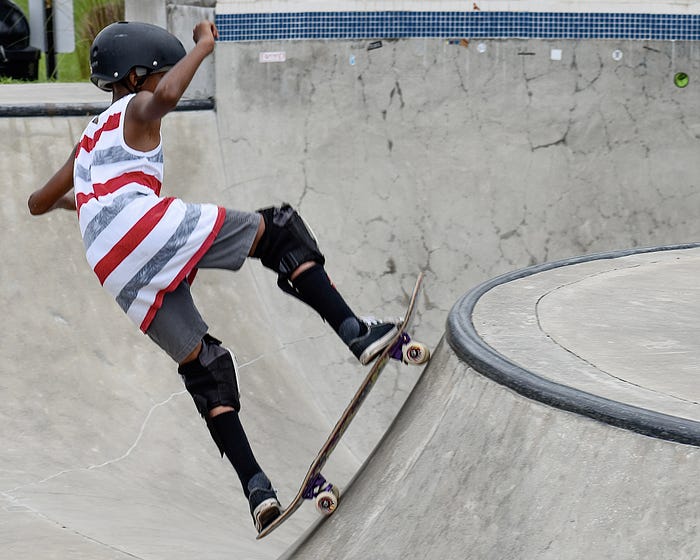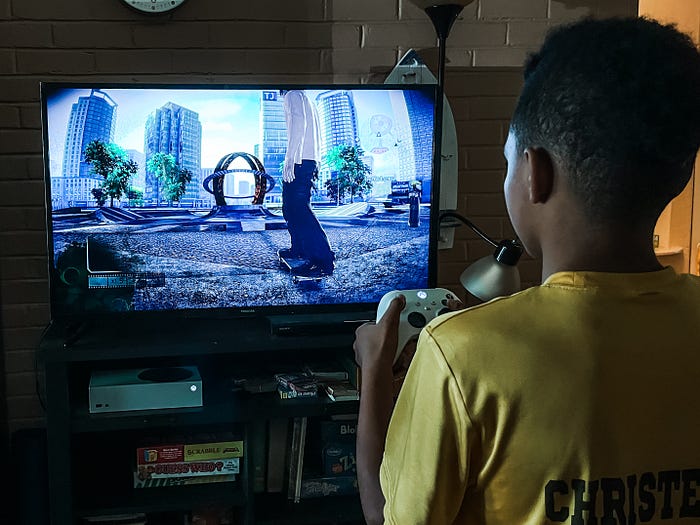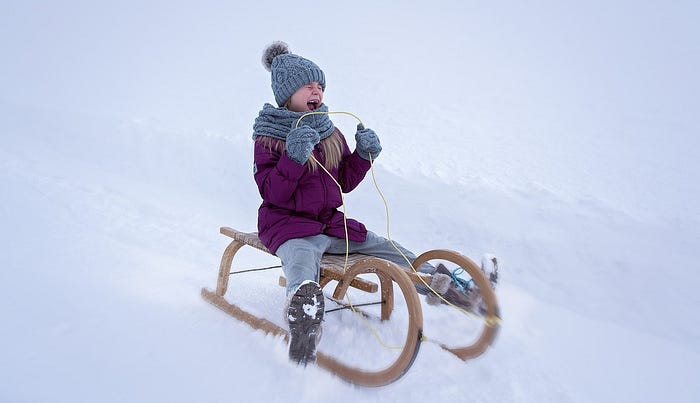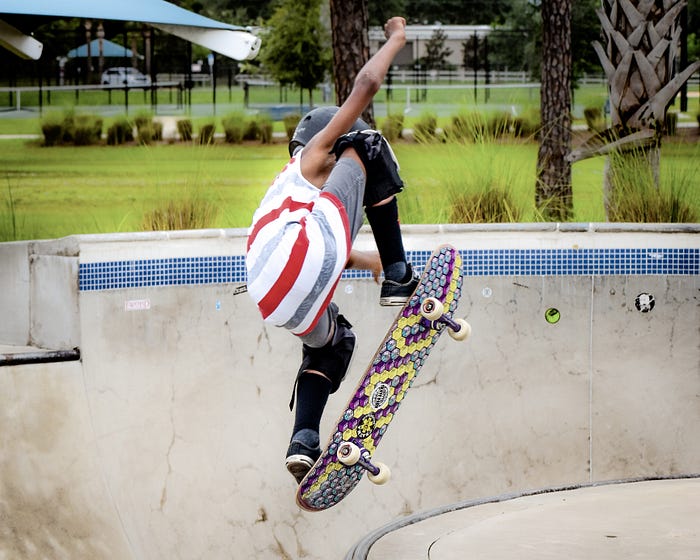When my younger son, Jacob*, broke his foot two times in a row, our life went on hold. Both of my boys typically spend about five or six days a week at the skatepark and the rest of their time playing hockey or BMX racing. But with Jacob in a cast, skatepark visits were reduced to two times a week, and the only way my older son, Silas, could enjoy time missed skateboarding was by playing the video game Skate on his Xbox.
Little did I know that it would not only make him a better skater but also improve his ability to predict outcomes in his surroundings and increase his spatial awareness.
Here's what happened.
He became a proficient skater
The struggle Jacob has with FASD (Fetal Alcohol Spectrum Disorder) and Autism made it hard for him to be compliant at the skatepark, especially when his activity was on hold with a broken foot. He already had frequent meltdowns when anxious or overstimulated.
Now, with the extra frustration from being in a cast, it became increasingly difficult to entertain him so his brother could skate.
Yet, as I watched Silas skate, I noticed three things:
1. He skated with boldness.
2. He was super fast!
3. He attempted more tricks than I had ever seen!

As I sat down to play Minecraft with Jacob, I suddenly became aware of a blur that whizzed by. Thinking it was another skater who entered the park, I continued playing on my iPad.
When the skater zoomed past us again, I looked up and saw that it was Silas! He was skating like a pro!
"How the heck did that happen?" I wondered as I got my phone out of my pocket and began recording immediately!
His style was impressive, his balance was spot on, and I was anxious to post a video of his performance on Instagram.
The first thing people noticed when watching one of my videos was his speed.
"Man! He's fast!" they exclaimed as they watched him zip around an almost empty skatepark.
Thankfully, we went early, and no one else was there, or I could have had two children in a cast.
Silas also suffers from brain damage that occurred when his birthmother drank alcohol when she was pregnant. But, with Silas, his executive functioning seems to have been affected the most, and he struggles with proprioception and visual-spatial deficits.
What is proprioception?
Proprioception has to do with a person's ability to perceive his body position in space, and visual-spatial deficits tend to present with the following characteristics:
- Difficulties locating something one can see, hear, or feel
- Difficulties plotting a route or course through one's environment, both when walking or driving
- Problems determining the distance from an object or person (even a car) in one's path and
- Difficulties following directions such as left, right, on top of, over, or under
These deficits have put Silas at risk of being hit by a car many times.
The game Skate
As I watched him play his video game one day, I saw him zoom through the course with abandon.

Suddenly, I realized that it was this very game that improved his form and increased his confidence at the skatepark!
He learned all these new tricks by practicing them repeatedly on the screen and in his mind!
A similar story
This brought to mind a story I heard a long time ago about a man named Major James Nesmith who liked to play golf. He thoroughly enjoyed the game but was just an average player.
One day, Major Nesmith was taken prisoner during the Vietnam War and placed in a tiny enclosure for seven years. He had no contact with others and nothing to stimulate his mind. He quickly realized he had to do something, or he would go crazy.
What did he do? He played a mental game of golf every day. But he didn't just think about playing golf. He visualized the entire experience.
He saw himself rising in the morning and getting dressed for the game. He visualized the smell of the green grass as he walked onto the course and gazed at the shrubs and trees decorating the hills. He even saw his golfing companions and chose different ones to play with daily.
In his mind, he went from hole to hole, picking the correct club for each shot. In the confines of his cage, he experienced the exhilaration of the game four hours a day, seven days a week, for seven years!
Upon his release, he went to play golf and found he had improved his game so much that he perfected his previous best by 24 strokes!
"The same thing must have happened to Silas!" I thought. He was literally perfecting his tricks and learning new ones in his mind!
Negative impacts from the game surface
However, something different happened the next time I watched him play the game. He was cruising on his board on the cement and heading straight toward a bowl when another skater entered the bowl perpendicular to where my son was about to enter. Though Silas saw the skater drop the bowl first, he plunged into the bowl anyway, and the other skater crashed right into him.
I was horrified!
This would be no big deal to a typical parent of a neurotypical child. But my vigilant parent mind suddenly stopped him from playing as I realized the dangers of practicing the wrong behavior over and over and over again, especially in light of the improvements he made in the sport after repeatedly playing the game.
Let me explain by telling you another story.
The girl on the sled
There is a story told among FASD support groups about a father who lived in Alaska that was watching his daughter sled down a hill.

At the bottom of the hill, another street intersected with her path, and he noticed an oncoming truck. He frantically tried to get her attention by waving and calling to warn her. She looked up at her waving father, then glanced at the truck, smiled while waving back to her father, and plunged down the hill.
This girl passed underneath the truck as she whisked through the snow and slowed to a stop as her father ran over to her.
Catching his breath, he asked, "Didn't you see the truck?"
"Sure," she said as she smiled.
"Then why did you go?" asked her father.
"I didn't know it was going to go there," she said, pointing to the bottom of the hill.
Due to the brain damage from her mother's consumption of alcohol while she was in the womb, the girl was not able to predict that the truck heading down the road would pass right in front of her.
This story illustrates how it is for my son.
He has been in many crashes and collisions because he cannot predict the future path of any approaching person or vehicle and does not seem to be able to judge the distance between himself and other people or objects appropriately.
It's a challenge to keep him and others safe!
Two days of no gaming
At first, I banned the game altogether. I reasoned that if he could get "so good" at skateboarding in real life by practicing repeatedly on a video game, the same thing could happen with his inability to predict the path of oncoming skaters (and cars!). I asked him to find a way to turn off other skaters so he could just skate solo, and when he couldn't, I shut the game down.
But a few days later, I had a thought.
This could be an excellent opportunity to practice the correct behavior.

"Ding!" Lightbulb moment.
A change of course
Now that we have a new strategy to help him practice increasing his visual-spatial awareness, I'm hoping it will transfer into real life.
I discovered that he can increase the number of people that are in the game. So, first, we started out slowly by allowing only one or two people in the park. As he plays, I watch for other skaters coming into the scene from the side or far away in front of him, and I alert him to their presence. Doing this has increased his awareness of his surroundings.
As he practices, becomes more aware, and learns not to crash into other skaters or pedestrians, we will increase the number of people allowed at the park.
We also practice in real life
Practicing the game also aligns with what we do at home. A lot of the time, I will call both boys to come into the house. Silas typically arrives before Jacob, comes through the door, closes it, and stands there petting the dog or talking.
With a few prompts, I get him to think about what could happen if he continues to stand in front of the closed door.
"Silas, where's Jacob?" I ask.
"He's coming," he replies.
"So where do you think he will go when he gets to the house?" I prompt.
"Through the door," he says, still not getting my point. He seems frustrated with me, like, I'm asking him a stupid question.
"Right. And what do you think will happen if he opens the door while you are standing there?"
"Oh," he says, finally understanding what I am getting at. "He will crash into me."
"Right," I say. "So you better come into the house and get away from the door."
These experiences happen every day. Thankfully, I have found another way to teach him to be more aware of where his body is and what's happening around him in a way that he enjoys.
In the long run, I'm confident it will help him learn to be safe in our chaotic world.
*Names have been changed to protect the identity of the children.


